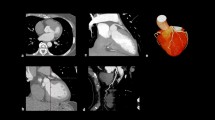Abstract.
Iodine-123 15-(p-iodophenyl)-3-R,S-methylpentadecanoic acid (BMIPP) can be used to image myocardial fatty acid regional distribution and utilisation with single-photon emission tomography (SPET). By visual analysis, a mismatching with regional uptake of BMIPP less than that of a perfusion tracer has been shown to predict myocardial viability and functional improvement after restoration of flow in patients with myocardial infarction. The current study aimed to evaluate a newly developed quantitative method of analysis of sestamibi and BMIPP uptake for the prediction of functional recovery after revascularization in patients with acute infarction. BMIPP and gated sestamibi SPET studies at rest were obtained before and >3 months after revascularization in 18 patients with recent infarction. A colour-coded polar map was generated from the comparison of sestamibi and BMIPP uptake. Depending on the relative distribution of the two tracers, different patterns of uptake were identified and their extent expressed as percentages of the surface of the whole left ventricle and of the three main coronary artery territories. At follow-up, recovery was defined as a ≥5% increase in ejection fraction compared with baseline. Receiver-operating characteristic curve analysis was performed to analyse the data. At baseline, significant correlations were found between ejection fraction and the % surface with decreased sestamibi or BMIPP uptake (r=–0.68, P= 0.001, and r=–0.72, P<0.0001, respectively). When combining both tracers, ejection fraction was significantly associated with the extent of myocardium showing decreased sestamibi uptake with lower BMIPP uptake (mismatching; r=–0.68, P=0.001). At follow-up, significant functional recovery was found in 13/18 patients. By ROC curve analysis, the optimal pattern of distribution predicting recovery was a mismatching with uptake of sestamibi <70% and uptake of BMIPP at least 10% lower. For this parameter, optimal cut-off of extent was 10% of the whole left ventricle surface (sensitivity 69%, specificity 80%, accuracy 72%) and 25% of the infarct-related arterial territory (sensitivity 77%, specificity 80%, accuracy 78%). The areas under the curve were 79% for the left ventricle surface and 72% for the individual arterial territories. These results suggest that in patients with acute infarction, quantitative analysis of sestamibi and BMIPP could offer an objective and reproducible method for estimating the severity of cardiac dysfunction and predicting the evolution of ejection fraction after revascularization.
Similar content being viewed by others
Author information
Authors and Affiliations
Additional information
Received 6 May and in revised form 23 June 2000
Electronic Publication
Rights and permissions
About this article
Cite this article
Hambÿe, AS., Vervaet, A., Dobbeleir, A. et al. Prediction of functional outcome by quantification of sestamibi and BMIPP after acute myocardial infarction. Eur J Nucl Med 27, 1494–1500 (2000). https://doi.org/10.1007/s002590000332
Published:
Issue Date:
DOI: https://doi.org/10.1007/s002590000332




